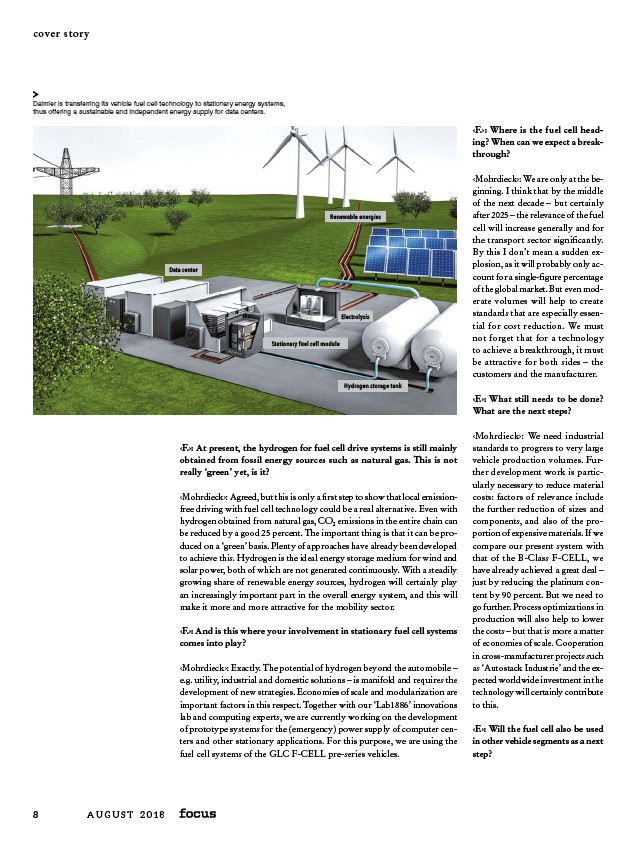
cover story
8 A U G U S T 2 0 1 8
‹F.›: At present, the hydrogen for fuel cell drive systems is still mainly
obtained from fossil energy sources such as natural gas. This is not
really ‘green’ yet, is it?
‹Mohrdieck›: Agreed, but this is only a first step to show that local emissionfree
driving with fuel cell technology could be a real alternative. Even with
hydrogen obtained from natural gas, CO2 emissions in the entire chain can
be reduced by a good 25 percent. The important thing is that it can be produced
on a ‘green’ basis. Plenty of approaches have already been developed
to achieve this. Hydrogen is the ideal energy storage medium for wind and
solar power, both of which are not generated continuously. With a steadily
growing share of renewable energy sources, hydrogen will certainly play
an increasingly important part in the overall energy system, and this will
make it more and more attractive for the mobility sector.
‹F.›: And is this where your involvement in stationary fuel cell systems
comes into play?
‹Mohrdieck›: Exactly. The potential of hydrogen beyond the automobile –
e.
g. utility, industrial and domestic solutions – is manifold and requires the
development of new strategies. Economies of scale and modularization are
important factors in this respect. Together with our ‘Lab1886’ innovations
lab and computing experts, we are currently working on the development
of prototype systems for the (emergency) power supply of computer centers
and other stationary applications. For this purpose, we are using the
fuel cell systems of the GLC F-CELL pre-series vehicles.
‹F.›: Where is the fuel cell heading?
When can we expect a breakthrough?
‹Mohrdieck›: We are only at the beginning.
I think that by the middle
of the next decade – but certainly
after 2025 – the relevance of the fuel
cell will increase generally and for
the transport sector significantly.
By this I don’t mean a sudden explosion,
as it will probably only account
for a single-figure percentage
of the global market. But even moderate
volumes will help to create
standards that are especially essential
for cost reduction. We must
not forget that for a technology
to achieve a breakthrough, it must
be attractive for both sides – the
customers and the manufacturer.
‹F.›: What still needs to be done?
What are the next steps?
‹Mohrdieck›: We need industrial
standards to progress to very large
vehicle production volumes. Further
development work is particularly
necessary to reduce material
costs: factors of relevance include
the further reduction of sizes and
components, and also of the proportion
of expensive materials. If we
compare our present system with
that of the B-Class F-CELL, we
have already achieved a great deal –
just by reducing the platinum content
by 90 percent. But we need to
go further. Process optimizations in
production will also help to lower
the costs – but that is more a matter
of economies of scale. Cooperation
in cross-manufacturer projects such
as ‘Autostack Industrie’ and the expected
worldwide investment in the
technology will certainly contribute
to this.
‹F.›: Will the fuel cell also be used
in other vehicle segments as a next
step?
Daimler is transferring its vehicle fuel cell technology to stationary energy systems,
thus offering a sustainable and independent energy supply for data centers.
Renewable energies
Data center
Electrolysis
Hydrogen storage tank
Stationary fuel cell module